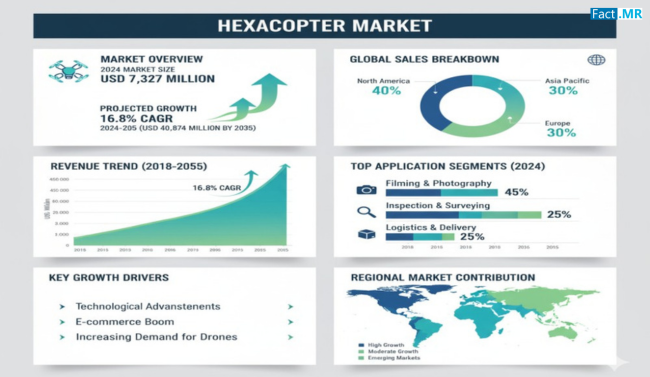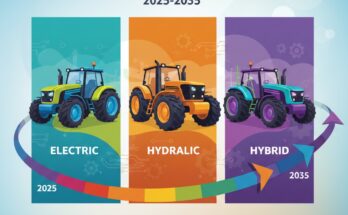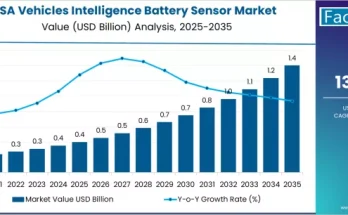As drone technology becomes an integral part of commercial, industrial, and recreational operations, the hexacopter market is emerging as a key segment in the unmanned aerial vehicle (UAV) industry. Hexacopters, featuring six rotors, offer superior stability, greater payload capacity, and enhanced maneuverability compared to traditional quadcopters. These advantages make them ideal for applications ranging from aerial surveillance and mapping to cinematography and agricultural monitoring.
With the rising need for precise, efficient, and flexible aerial solutions, hexacopters are becoming a preferred choice for industries seeking to improve operational performance while embracing advanced drone technologies.
Market Overview
Hexacopters are designed to provide stability and redundancy, ensuring uninterrupted flight even if one rotor fails. Their robust structure and six-rotor configuration allow them to carry heavier payloads, making them suitable for professional applications such as high-resolution imaging, environmental monitoring, and industrial inspections.
Technological advancements, including enhanced battery life, GPS-based navigation, autonomous flight modes, and integrated sensors, have significantly expanded their capabilities. Hexacopters can perform complex aerial tasks with precision and efficiency, reducing the need for manual labor and minimizing operational risks.
The growing interest in commercial and industrial drone applications is driving innovation in the hexacopter market. Manufacturers are developing lightweight, foldable, and energy-efficient models that cater to urban mobility, logistics, and recreational use, making them increasingly accessible to a broader user base.
Regional Insights
The hexacopter market exhibits varied adoption across different regions, influenced by infrastructure development, regulatory frameworks, and technological advancement.
North America is a leading market due to widespread UAV adoption in defense, commercial, and recreational sectors. Advanced infrastructure, coupled with supportive regulations for drone operations, has accelerated the deployment of hexacopters for surveillance, inspection, and aerial photography.
Europe is witnessing significant growth, with strict regulations ensuring safety and operational compliance. European industries are utilizing hexacopters for precision agriculture, environmental monitoring, and urban planning, benefiting from technological integration and operational reliability.
Asia-Pacific is an emerging market, driven by expanding commercial and industrial sectors, increasing drone services, and growing demand for automation in agriculture and logistics. Investment in UAV technology and the adoption of smart city initiatives are further supporting hexacopter market growth in the region.
Other regions, including Latin America and the Middle East & Africa, are gradually adopting hexacopters for industrial applications, environmental research, and security purposes, reflecting a growing recognition of UAVs’ operational advantages.
Key Trends & Forecast
Several trends are influencing the growth and development of the hexacopter market:
- Increased Payload and Stability: Hexacopters are designed to carry heavy payloads, making them suitable for professional photography, surveying, and delivery operations.
- Automation and Smart Navigation: AI-driven flight controls, autonomous navigation, and obstacle detection systems are enhancing operational efficiency and safety.
- Expansion of Commercial Applications: Industries such as agriculture, construction, logistics, and energy are increasingly adopting hexacopters to optimize productivity and reduce operational costs.
- Environmental Monitoring and Disaster Management: Equipped with advanced sensors, hexacopters are being used for environmental studies, wildlife monitoring, and disaster response.
- Regulatory Support: Governments are introducing UAV regulations and airspace integration guidelines, enabling safe and widespread commercial adoption.
- Integration with IoT and Data Analytics: Hexacopters are evolving into data platforms, providing real-time insights for operational decision-making across industries.
These trends indicate a strong trajectory for the hexacopter market, as industries seek reliable, precise, and efficient aerial solutions to meet operational and environmental goals.
Applications & End-Use Outlook
Hexacopters are increasingly used across multiple sectors due to their adaptability and operational advantages:
- Industrial Inspections: Used for infrastructure inspection, including pipelines, power lines, and communication towers, enhancing safety and reducing labor intensity.
- Agriculture: Employed in precision farming for crop monitoring, irrigation planning, and aerial mapping to improve yield and efficiency.
- Media and Entertainment: Hexacopters provide stable aerial photography and cinematography, enabling innovative content creation.
- Logistics and Delivery: Utilized for urban deliveries and last-mile logistics, particularly in areas where conventional transport is inefficient.
- Security and Surveillance: Deployed for law enforcement, border security, and emergency response operations.
- Environmental Research: Hexacopters assist in wildlife monitoring, forest management, and disaster assessment, providing real-time data in challenging terrains.
The wide-ranging applications demonstrate the hexacopter’s versatility and its role in enhancing operational efficiency across commercial, industrial, and recreational domains.
Conclusion
The hexacopter market is poised to transform aerial operations by offering advanced stability, increased payload capacity, and versatile functionality. These UAVs enable industries to execute complex tasks efficiently and safely, reducing labor costs and operational risks while supporting technological innovation.
As automation, AI integration, and flight precision continue to advance, hexacopters will play a pivotal role in industrial inspections, precision agriculture, logistics, and creative applications. The growing adoption across regions reflects the market’s potential to redefine aerial solutions, enhance operational efficiency, and contribute to sustainable, technology-driven growth.
Hexacopters are more than drones—they represent the next generation of aerial tools, delivering reliability, precision, and strategic advantages for modern industries and recreational users alike.
Browse Full Report – https://www.factmr.com/report/hexacopter-market



